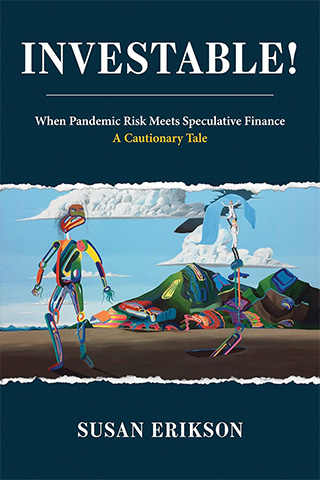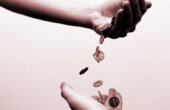The Business of Betting on Catastrophe

The pandemic bonds — a financial device made up by one of the world’s most powerful institutions, the World Bank — can seem like a great idea for raising money to fight pandemics. Money is pooled ahead of time, rather than waiting for governments to pony up monies to stop a deadly infectious disease after it spreads. Private investors speculate on the risk of pandemic, putting their money into a special World Bank account, earning interest on the money they invest, what’s called their principal. If a pandemic happens, investors lose their principal to organizations that fight disease, thwarting contagion before it escalates. If there’s no pandemic, investors get their principal money back, in addition to interest. In a world where the risk of pandemic outbreak is ever-present, making risk the thing that investors buy is, at the very least, interesting.

Soon after the idea for the pandemic bonds was first floated by the World Bank in 2014, I applied for a grant to study these kinds of investments and got it. As the puzzle pieces of my research began falling into place, the role of insurance-linked securities (ILS) emerged as an element I could not ignore. (I tried.) The problem was that I had no idea what ILS was. Hadn’t known the industry existed. Knew no one in the industry. Zilch. How would I even study it?
Googling around in the summer of 2017, I learned of an international reinsurer’s conference in Baden-Baden, Germany. By that point, I had learned enough to know that ILS grew out of the reinsurance industry in the mid-1990s, as insurers tried to deepen and diversify their portfolios so they wouldn’t run out of money when big weather events hit. I know Germany well, did my PhD research there, and speak some German. Off I went.
Every autumn, for about 50 years now, 2,000-odd reinsurers take over the German town known for its curative hot spring spas, and a picturesque stone canal graced with impeccably pruned ivy, with white swans so big I wondered about steroids in the water. In the town typically thick with tourists, for four days each year, serious-faced, mostly white businessmen (5 to 1, men to women) rush around in dark suits and Oxford brogues, conferencing in buildings along the canal. By night, it’s a Bavarian junket where the boldest among them join in stays-in-Vegas frivolities. In a local café, I overheard a group from a Toronto company bragging about staying out until 5:00 a.m. but triumphantly making it to their 9:00 a.m. meeting. They reminded me of my high school friends who were model students 360 days a year but lived to let loose for that one week at band camp.
The draw for investors is the quid pro quo: If ILS investors hold the risk of something terrible happening, they have the chance to make significant returns.
The first hours at the conference venue, I had no idea what was going on. There was no conference schedule, no expert panels, and no nametags. It felt like being in a village that doesn’t have street signs because everyone there already knows where everything is. Official conference registration proved useful for only one thing: getting an online directory of other attendees’ contact information. The conference was just a series of appointments. Who knew? Obviously, all the other attendees.
In the big, boxy, glass Kongresshaus (convention hall), on four huge, cavernous levels with floor-to-ceiling windows, hundreds of reinsurers met each other at numbered tables three to eight feet apart, two to six people per table. As they settled into their chairs, they placed their business cards in front of them like totemic offerings. The “conference” was these 30-minute meetings, like a variation of speed dating, pre-scheduled by the conference-goers themselves, one right after the other. There was a class structure to the conference: the corporate presidents and vice presidents weren’t in the Kongresshaus. In bespoke Italian silk suits, they conduct their deal-making in the posh five-star hotels along the swan-filled canal, entertaining each other with top-shelf liquor and caviar.
Everyone was there to either enliven business relationships that already worked well or to sort prospective collegial kernel from undesirable chaff. They vetted each other unapologetically. “It’s all about trust,” two reinsurers from Tbilisi, Georgia, told me as we traveled together on the public bus from our hotel to the Kongresshaus. “We need to trust people to do insurance. We want to look across the table and see what’s in someone’s face.” “The industry is mired in legacy,” a 30-something reinsurer told me, “which a lot of people put down to using relationships instead of technology. People are still trying to do business in the same way they have for 100 years.”
Not knowing any of this, I had scheduled only two appointments. But my luck turned late in the first day when I met an insurance executive in the women’s restroom, of all places, who introduced me to some folks, who introduced me to others, one of whom was a reinsurance executive who had worked with the World Bank on the pandemic bonds design. I was in the right place.
For millennia, humans have tried to come up with ways to ensure that life’s tragedies don’t devastate them for the rest of their lives. Insurance has been around in recognizable form for over 4,000 years. Reinsurance — providing insurance for insurance companies concerned that their businesses could be wiped out by a major claims event — has been around since the 1800s. Alternative risk transfer (ART) — the category of the global insurance industry that ILS falls into — emerged in the 1970s as a way for investors to provide an extra layer of financial protection, through additional diversification, for extreme weather and mortality events that threatened to bring down whole companies. ART instruments are designed to pool financial assets from hedge funds and pensions, getting their money managers to gamble on securitized risks. Pandemic bonds are ARTS.
ILS, which started up in the mid-1990s, gassed up opportunities for short-term, high-yield risk investments as a response to what pioneer ILS-ers considered the slow, stodgy way insurance was done. “We were looking at how the insurance industry was made and where the capital came from, seeing if we could identify opportunities to make transactions work more effectively and efficiently,” a prominent ILS expert told me. What do you mean by efficiency? I asked. Lower operating costs, cheaper borrowing. A loan might cost 3 or 4 percent, “but I might be able to pay investors less than that depending on the risk they’re covering,” they said. “We didn’t start out thinking that ILS was going to help governments or do humanitarian aid, like it does now. At first, it was really just a case of the insurance industry finding more efficient ways to source the costs of doing business.”
New “efficiency features” regularly get introduced in ILS and written into contracts. One of the most transformative has been the use of parametrics. Unlike traditional insurance, which calculates payouts based on actual losses (what’s called indemnity), parametric insurance uses preset triggers to determine whether money gets released. During an interview, a London-based parametric expert gave me this example of a parametric scenario: If, during a hurricane, wind speeds off the Florida coast hit a predetermined trigger speed — say 175 mph — at a trigger distance of two miles offshore within a preset longitude and latitude grid, the payout is, in theory, immediate. No actual damage need occur; the trigger measures just need to be met. This parametric payout scenario was piloted several years ago. In this simulation, the London-base expert told me, some people were able to get insurance payouts immediately via their phone once the data on speed, distance, and location criteria were verified. Others were slowed by the trouble they had with the phone app.
If COVID-19 hadn’t triggered the bond, those investors would have earned a 40 percent return on their principal investment over the three-year life of the bond.
Parametric triggers, like the death counts build into the pandemic bonds (meaning a certain number of people had to die before any money was released), were hugely popular in the early aughts, a time when indemnity-based triggers declined. “[For parametrics], I’m really big on pushing the tech, like using satellites,” one ILS consultant told me. “We’ve seen crop insurance in Ethiopia that pays out based on how green the earth is because it’s moisture related. [People] are looking at wildfire and burn scars, so payout would be based on that.” Another told me, “A CEO might want these new sensor sticks that attach to a factory wall. They get a payout when flood waters hit a certain level. People in the industry have figured out that parametrics are really good when a company needs fast cash. A chief financial officer is going to be very aware that when a big hurricane happens, they’re going to take a massive hit and need capital quite quickly to pay claims and things, and ILS will be a $100 million layer that pays out.”
Early on, my biggest mental stumbling block was in assuming that the pandemic bonds were a kind of insurance for some thing. Hospital facilities? An economy? Sick human bodies? No. Insurance-linked securities investors speculate on risk itself. ILS doesn’t trade in things or commodities; its investors buy risk. It bears repeating that the pandemic bonds covered the risk that a pandemic would happen. The draw for investors is the quid pro quo: If ILS investors are willing to hold the risk of something terrible happening for a period of time, they have the chance to make significant returns. Like with the World Bank’s Class B pandemic bond: If COVID-19 hadn’t triggered the bond, those investors would have earned a 40 percent return on their principal investment over the three-year life of the bond.
ILS is a small but booming market industry, a $195 billion offshoot of the $5 trillion global insurance industry. Its products have grown in popularity because their contractual details are tied to modeled probabilities, like those for pandemic risk, rather than large-scale “exposures” where monetary gain lies in the profit margins between what people paid in premiums before their houses did burn down and all the other people who also paid for housefire coverage just in case.
ILS gives investors a different set of conditions for making money (and losing it), an attractive diversification feature. ILS gains and losses are very specific: Investors make (or lose) money by speculating on specific variables of a specific catastrophe, like where and when and at what intensity a catastrophe will happen in the future. Long before the World Bank’s bonds, ILS was busy priming for the investability of pandemic risk.
Susan Erikson is an anthropologist and Distinguished Professor at Simon Fraser University in Vancouver, British Columbia, Canada, where she studies complex political and economic systems that shape human health. She is the author of “Investable! When Pandemic Risk Meets Speculative Finance – A Cautionary Tale,” from which this article is adapted.



